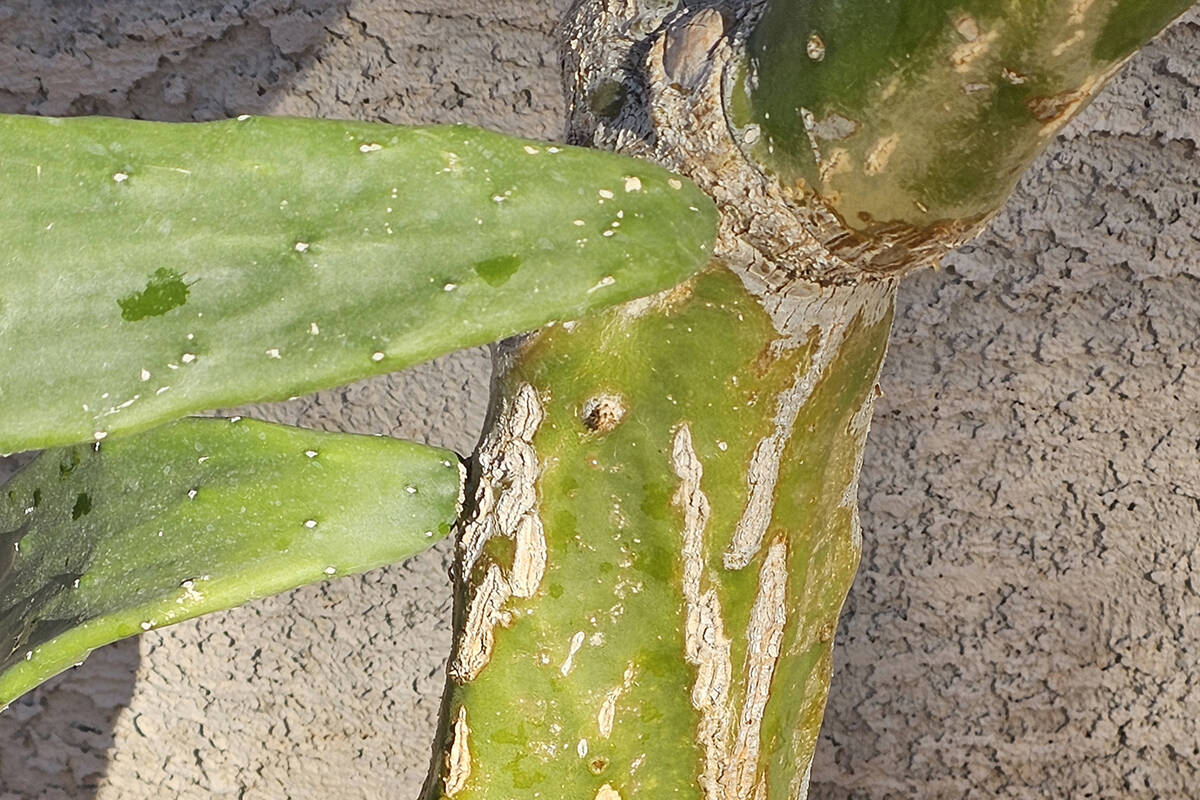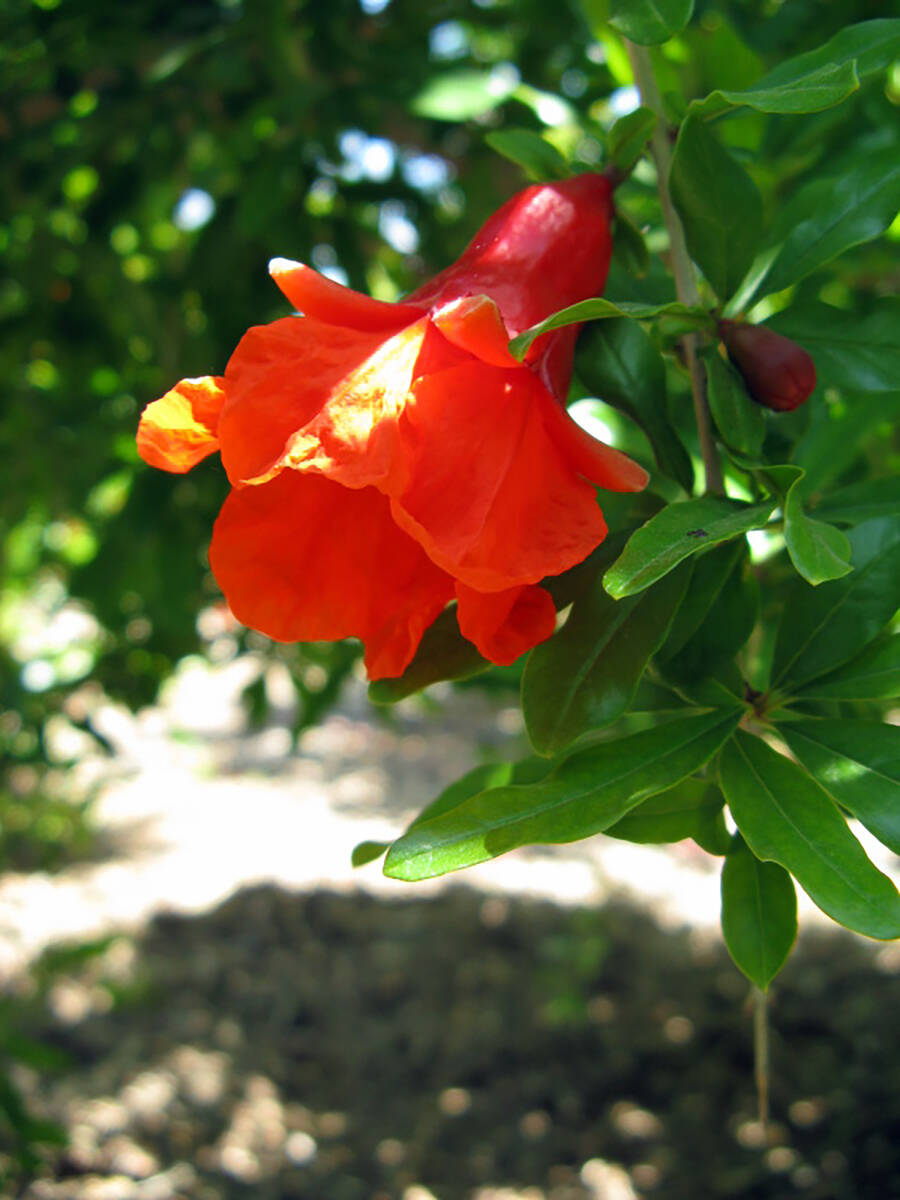Does woody ‘rash’ on cactus indicate a problem?
Q: What is the “rash” on my cactus that I’m seeing?
A: I believe that’s just older growth. Older streaks are from the accumulation of suber, or corky tissue. These “rashes” also may happen when a cactus is damaged by disease (in this case, root rot) or because it’s watered too often or by wire used to hold it for support. I water my beaver tail about every three weeks during the summertime if I want it to grow large. I water it less, about every eight to 10 weeks, if I want it to stay small. Some beaver tail can get over 15 feet tall.
You can prune it a few inches from the ground and get soft, succulent green growth if you want that. Otherwise, this rash is natural and not to be too concerned about.
This cactus is native to the drier parts of Mexico and the southwest United States. They grow as natives in the Sonoran Desert as well as the Mojave. If I am right, they should start to develop cylindrically shaped fruit after they flower. Flowering should start as it gets older. Flowers are usually yellow or red, waxy looking and very beautiful. This woody rash is something normal that develops as the plant gets bigger and older.
Q: What type of borers attack our local trees? Do these same borers get into fruit trees?
A: I am told by entomologists that the borers that attack our local trees are a particular type of flathead borer. These are general feeders so they also get into many different types of landscape as well as fruit trees. The adults are three-eighths-of-an-inch beetles that can fly once they emerge. That is how they get around and spread.
Their emergence from trees and eventual flight (I am guessing now from my experience) is normally in spring, usually early March in our climate. I am told by entomologists that emergence can happen at any time of year, but that has not been my observation. Entomologists say that the females seek out sun-damaged trees for laying their eggs.
Tree professionals use a systemic insecticide for controlling borers. This insecticide may be sprayed on the trunks of infested trees. It comes in different trade names. The active ingredient is imidacloprid, a common insecticide used for many kinds of insects on many kinds of crops.
Homeowners can make the same application of this chemical by using it as a “root drench” around infested trees. The insecticide used is as systemic, which means it spreads all through the tree once applied to the roots. Because of this, I do not recommend eating the fruit for one season after treatment, although there are labels that permit eating the fruit in the same season that it’s treated. One treatment is reportedly good for about 12 months.
The time of treatment is usually about February or March, soon after landscape plants or fruit trees finish flowering. This systemic insecticide treatment has been implicated in colony collapse disease of honeybees. That’s why I tell people to apply it after the plant finishes flowering.
Q: What are the best insect traps to hang in our fruit trees? When is that done?
A: These insects are also called borers, but they are a different kind, called a coddling moth. Some of these get into the fruit of apples and pears. This insect is what creates wormy apples.
Other types of borers infest “stone fruit” such as peaches and nectarines. Those are called peach twig borers. It’s given that name because it may infest peach twigs before the tree begins flowering. After it finishes flowering, this same insect continues to infest the fruit. This dying of twig growth is how I identify the insect early, and it must be trapped. Peach twig borers fly a little bit earlier in the season than coddling moths, but otherwise the adult moths look very similar.
The damage that causes early fruit to fall are called stings. Sometimes young apples will be found on the ground that have been stung. If you cut that fruit open, a small worm will be found.
The coddling moth and peach twig borer are two different types of insects, so we have to use two different types of pheromones to trap them.
I prefer to use winged traps that are open on all sides, rather than the less-expensive delta traps that are open only on two sides. I feel that there is a better distribution of the pheromone in the orchard for trapping.
Peach twig borer traps are put into peach trees when peach trees first begin blooming during the first couple of weeks of February. Coddling moth traps are first put into apple trees when they begin flowering about a month or so later.
The pheromones inside the traps are replaced once a month. I have had no problems with any of the insects since using the pheromones.
Q: When planting new shrubs or relocating plants I apply a local nursery’s plant tonic. Can fish fertilizer be used as a supplement along with a plant tonic or with normal regular spring and fall season fertilizer applications to substitute for it?
A: Sometimes nurseries develop their own plant tonic and sell it to compete with a nationally advertised brand. As far as your nursery’s claim that it improves transplant success, to my knowledge it is not documented. In my opinion, you are much better off improving the soil by adding the right kind of starter fertilizer at the beginning. Some professionals swear by it, and some professionals swear at it.
There is nothing wrong with adding it at the same time as your favorite fish fertilizer. They will not interfere with each other. Fertilizer applications with a plant tonic are OK if the soil has been improved with organic amendments such as compost. Our soils are extremely low in organic material, and compost is the most effective way of rebuilding the organic matter in the soil. If you don’t do this, the use of fertilizers, fish emulsion and plant tonics won’t help. They do not substitute for soil improvement.
Q: I attended one of your classes on trimming fruit trees a few years back and got some good tips for our pomegranate bush. The bush looks very healthy, but it has no blossoms. Other pomegranate plants in our neighborhood have lots of blossoms. Is there anything I can do to correct this situation?
A: Yes, be patient. If the plant has been pruned, removing a fair amount of growth, the pomegranate may push its energy into new growth before it flowers. Try not pruning next year, then tell me what happened. My guess is that it will start flowering if it’s at least 3 to 6 years old. Pomegranate flowers continuously on new growth during the spring, so be patient.
Q: My pistachio trees have a blight that I have been addressing with a fungicide, which doesn’t seem to be very effective. I recently heard of another fungicide that might be more effective. I’d like your suggestions for the most effective fungicide and where I can obtain it, plus how and when to apply it.
A: You didn’t tell me the problem. Maybe it’s not a disease? First, make sure it’s a disease that you’re treating and not something else. Plant diseases are easily confused with other problems, including environmental and insect problems.
I would suggest contacting a certified plant pathologist, unless you want to start learning about different fungicides. Fungicides, like antibiotics, are in different classes. Switch to a different class of fungicide when making treatment. That’s all I can tell you without getting into more detail.
Bob Morris is a horticulture expert and professor emeritus of UNLV. Visit his blog at xtremehorticulture.blogspot.com. Send questions to Extremehort@aol.com.






























